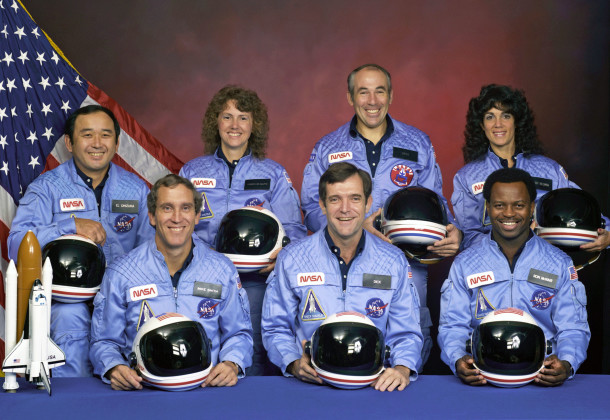
Thirty years ago today, the seven member crew of STS-51L were killed when the Space Shuttle Challenger disintegrated 73 seconds after launch from LC-39B at Cape Canaveral, Florida. The tragedy was the first fatal in-flight mishap in the history of American manned spaceflight.
In remarks made at a memorial service held for the Challenger Seven in Houston, Texas on Friday, 31 January 1986, President Ronald Wilson Reagan expressed the following sentiments:
“The future is not free: the story of all human progress is one of a struggle against all odds. We learned again that this America, which Abraham Lincoln called the last, best hope of man on Earth, was built on heroism and noble sacrifice. It was built by men and women like our seven star voyagers, who answered a call beyond duty, who gave more than was expected or required and who gave it little thought of worldly reward.”
We take this opportunity to remember the noble fallen:
Francis R. (Dick) Scobee, Commander
Michael John Smith, Pilot
Ellison S. Onizuka, Mission Specialist One
Judith Arlene Resnik, Mission Specialist Two
Ronald Erwin McNair, Mission Specialist Three
S.Christa McAuliffe, Payload Specialist One
Gregory Bruce Jarvis, Payload Specialist Two
Speaking for grieving families and countrymen, President Reagan closed his eulogy with these words:
“Dick, Mike, Judy, El, Ron, Greg and Christa – your families and your country mourn your passing. We bid you goodbye. We will never forget you. For those who knew you well and loved you, the pain will be deep and enduring. A nation, too, will long feel the loss of her seven sons and daughters, her seven good friends. We can find consolation only in faith, for we know in our hearts that you who flew so high and so proud now make your home beyond the stars, safe in God’s promise of eternal life.”
Tuesday, 28 January 1986. We Remember.
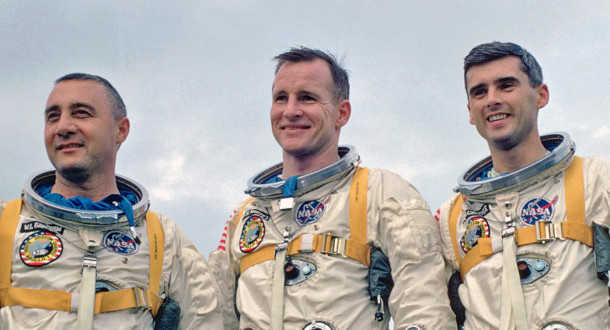
Forty-nine years ago today, the Apollo 204 prime crew perished as fire swept through their Apollo Block I Command Module (CM). The Apollo 204 crew of Command Pilot Vigil I. “Gus” Grissom, Senior Pilot Edward H. White II and Pilot Roger B. Chaffee had been scheduled to make the first manned flight of the Apollo Program some three weeks hence.
On Friday, 27 January 1967, during a plugs-out ground test on LC-34 at Cape Canaveral, Florida, a fire broke out in the Apollo 204 spacecraft at 23:31:04 UTC (6:31:04 pm EST). Shortly after, a chilling cry was heard across the communications network from Astronaut Chaffee: “We’ve got a fire in the cockpit”.
Believed to have started just below Grissom’s seat, the fire quickly erupted into an inferno that claimed the men’s lives in less than 30 seconds. While each received extensive 3rd degree burns, death was attributed to toxic smoke inhalation.
The Apollo 204 fire was most likely brought about by some minor malfunction or failure in equipment or wire insulation. This failure, which was never positively identified, initiated a sequence of events that culminated in the conflagration.
The post-mishap investigation uncovered numerous defects in CM Block I design, manufacturing, and workmanship. The use of a (1) pure oxygen atmosphere pressurized to 16.7 psia and (2) complex 3-component hatch design (that took a minimum of 90 seconds to open) sealed the astronauts’ fate.
A haunting irony of the tragedy is that America lost her first astronaut crew, not in the sideral heavens, but in a spacecraft that was firmly rooted to the ground.
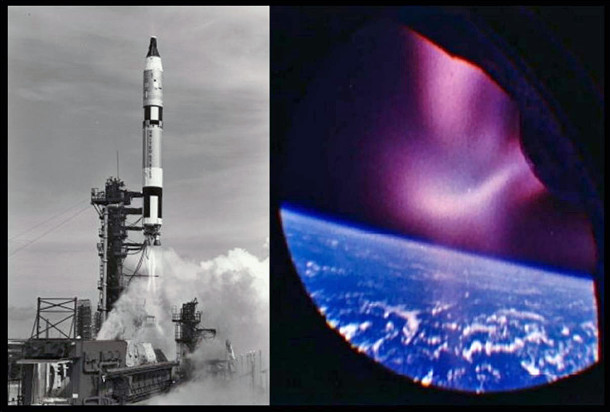
Fifty-one years ago to the day, NASA successfully completed the unmanned Gemini-Titan 2 (GT-2) space mission. The suborbital spaceflight served as a final test that cleared the way for the first manned Gemini orbital mission (GT-3) flown several months later.
The Gemini Program was America’s second manned space project. Gemini pioneered key technologies required to land men on the Moon including space navigation, rendezvous, docking, orbital maneuvering, long-duration spaceflight and extra-vehicular activity (EVA). Without Gemini, the United States would not have achieved the goal of landing men on the Moon before the end of the 1960’s.
The two-man Gemini spacecraft weighed 8,500 pounds at lift-off and measured 18.6 feet in length. Gemini consisted of a reentry module (RM), an adapter module (AM) and an equipment module (EM).
The crew occupied the RM which also contained ships’ navigation, communication, telemetry, electrical and reentry reaction control systems. The AM contained maneuver thrusters and the deboost rocket system. The EM included the spacecraft orbital attitude control thrusters and the fuel cell system. Both the AM and EM were used in orbit only and discarded prior to entry.
A two-stage Titan II launch vehicle served as the chariot that Gemini rode into space. Designed for the Intercontinental Ballistic Missile (ICBM) role, the native reliability of the Titan II had to be substantially improved for the vehicle to safely carry men into space. The history of spaceflight records that the man-rated Titan II truly fulfilled the measure of its creation by successfully launching ten (10) Gemini crews into earth orbit.
Gemini-Titan (GT-2) was the second and last unmanned flight test of the Gemini spacecraft. Since the primary goal was to flight-prove the craft’s heat shield performance during reentry, the mission was suborbital in nature. GT-2 lifted-off from Cape Canaveral’s LC-19 at 14:22:14 UTC on Tuesday, 19 January 1965. The vehicle’s arcing ballistic trajectory took it over the Atlantic Ocean on a flight that lasted only 18 minutes and 16 seconds. Maximum altitude and impact range were 92.4 nm and 1,847.5 nm, respectively.
Gemini 2’s ablative heat shield functioned as designed and came through the fiery reentry in excellent condition. Most of the spacecraft’s other flight systems performed satisfactorily during the vehicle’s brief sojourn into the heavens. Exceptions here included the fuel cell system which failed prior to lift-off and cooling system temperatures which exceeded design requirements.
Gemini 2’s splashdown point was situated approximately 45 nm from the USS Lake Champlain. About 90 minutes after splashdown, Gemini 2 was hauled aboard the recovery ship. Engineers found that the spacecraft came through the flight in such good shape that it actually flew a second suborbital reentry in November of 1966. Along with the OPS 0855 boilerplate spacecraft, the Gemini 2 reentry module was flown aboard a Titan IIIC launch vehicle in support of the USAF Manned Orbiting Laboratory (MOL) Program.
The successful completion of GT-2 (along with the previous GT-1 orbital mission) provided NASA with the confidence needed to proceed with manned Gemini missions. The first of ten (10) such missions, GT-3, was successfully flown in March of 1965. A mere 20 months later (December 1966), the Gemini Program was brought to a successful conclusion with the splashdown of Gemini 12.
The Gemini Program was remarkable for its many significant and historic spaceflight achievements that paved the way to the moon. The brief mission of Gemini-Titan 2 was a small, but important part of that larger story. Today, aerospace aficionados can view the twice-flown Gemini 2 reentry module at the Air Force Space and Missile Museum, Cape Canaveral, Florida.
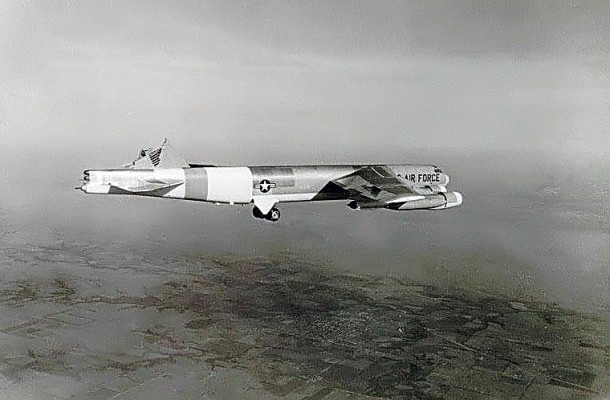
Fifty-two years ago this week, a USAF/Boeing B-52H Stratofortress landed safely following structual failure of its vertical tail during an encounter with unusually severe clear air turbulence. The harrowing incident occurred as the aircraft was undergoing structural flight testing in the skies over East Spanish Peak, Colorado.
Turbulence is the unsteady, erratic motion of an atmospheric air mass. It is attributable to factors such as weather fronts, jet streams, thunder storms and mountain waves. Turbulence influences the motion of aircraft that are subjected to it. These effects range from slight, annoying disturbances to violent, uncontrollable motions which can structurally damage an aircraft.
Clear Air Turbulence (CAT) occurs in the absence of clouds. Its presence cannot be visually observed and is detectable only through the use of special sensing equipment. Hence, an aircraft can encounter CAT without warning. Interestingly, the majority of in-flight injuries to aircraft crew and passengers are due to CAT.
On Friday, 10 January 1964, USAF B-52H (S/N 61-023) took-off from Wichita, Kansas on a structural flight test mission. The all-Boeing air crew consisted of instructor pilot Charles Fisher, pilot Richard Curry, co-pilot Leo Coors, and navigator James Pittman. The aircraft was equipped with accelerometers and other sensors to record in-flight loads and stresses.
An 8-hour flight was scheduled on a route that from Wichita southwest to the Rocky Mountains and back. The mission called for 10-minutes runs of 280, 350 and 400 KCAS at 500-feet AGL using the low-level mode of the autopilot. The initial portion of the mission was nominal with only light turbulence encountered.
However, as the aircraft turned north near Wagon Mound, New Mexico and headed along a course parallel to the mountains, increasing turbulence and tail loads were encountered. The B-52H crew then elected to discontinue the low level portion of the flight. The aircraft was subsequently climbed to 14,300 feet AMSL preparatory to a run at 350 KCAS.
At approximately 345 KCAS, the Stratofortress and its crew experienced an extreme turbulence event that lasted roughly 9 seconds. In rapid sequence the aircraft pitched-up, yawed to the left, yawed back to the right and then rolled right. The flight crew desperately fought for control of their mighty behemoth. But the situation looked grim. The order was given to prepare to bailout.
Finally, the big bomber’s motion was arrested using 80% left wheel authority. However, rudder pedal displacement gave no response. Control inputs to the elevator produced very poor response as well. Directional stability was also greatly reduced. Nevertheless, the crew somehow kept the Stratofortress flying nose-first.
The B-52H crew informed Boeing Wichita of their plight. A team of Boeing engineering experts was quickly assembled to deal with the emergency. Meanwhile, a Boeing-bailed F-100C formed-up with the Stratofortress and announced to the crew that most of the aircraft’s vertical tail was missing! The stricken aircraft’s rear landing was then deployed to add back some directional stability.
With Boeing engineers on the ground working with the B-52H flight crew, additional measures were taken in an effort to get the Stratofortress safely back on the ground. These measures included a reduction in airspeed, controlling aircraft center-of-gravity via fuel transfer, judicious use of differential thrust, and selected application of speedbrakes.
Due to high surface winds at Wichita, the B-52H was vectored to Eaker AFB in Blytheville, Arkansas. A USAF/Boeing KC-135 was dispatched to escort the still-flying B-52H to Eaker and to serve as an airborne control center as both aircraft proceeded to the base. Amazingly, after flying 6 hours sans a vertical tail, the Stratofortress and her crew landed safely.
Safe recovery of crew and aircraft brought additional benefits. There were lots of structural flight test data! It was found that at least one gust in the severe CAT encounter registered at nearly 100 mph. Not only were B-52 structural requirements revised as a result of this incident, but those of other existing and succeeding aircraft as well.
B-52H (61-023) was repaired and returned to the USAF inventory. It served long and well after its close brush with catastrophy in January 1964. The aircraft spent the latter part of its flying career as a member of the 2nd Bomb Wing at Barksdale AFB, Louisiana. The venerable bird was retired from active service in July of 2008.
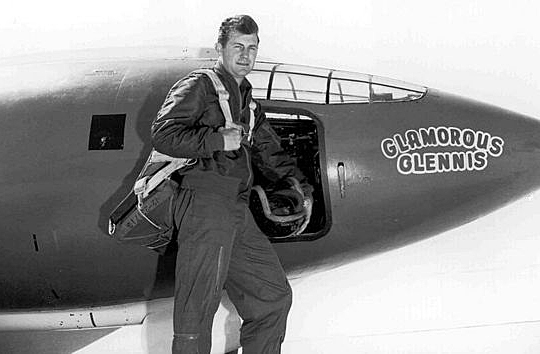
Sixty-seven years ago today, the USAF/Bell XS-1 became the first aircraft of any type to achieve supersonic flight during a climb from a ground take-off. The daring feat took place at Muroc Air Force Base with USAF Captain Charles E. “Chuck” Yeager at the controls of the rocket-powered XS-1.
Rocket-powered X-aircraft such as the XS-1, X-1A, X-2 and X-15 were air-launched from a larger carrier aircraft. With the test aircraft as its payload, this “mothership” would take-off and climb to drop altitude using its own fuel load. This capability permitted the experimental aircraft to dedicate its entire propellant load to the flight research mission proper.
The USAF/Bell XS-1 was the first X-aircraft. It was carried to altitude by a USAF/Boeing B-29 mothership. XS-1 air-launch typically occurred at 220 mph and 22,000 feet. On Tuesday, 14 October 1947, the XS-1 first achieved supersonic flight. The XS-1 would ultimately fly as fast as Mach 1.45 and as high as 71,902 feet.
All but two (2) of the early X-aircraft were Air Force developments. The exceptions were products of the United States Navy flight research effort; the USN/Douglas D-558-I Skystreak and USN/Douglas D-558-II Skyrocket. The Skystreak was a turbojet-powered, straight-winged, transonic aircraft. The Skyrocket was supersonic-capable, swept-winged, and rocket-powered. Each aircraft was originally designed to be ground-launched.
In the best tradition of inter-service rivalry, the Navy claimed that the D-558-I at the time was the only true supersonic airplane since it took to the air under its own power. Interestingly, the Skystreak was able fly beyond Mach 1 only in a steep dive. Nonetheless, the Air Force was indignant at the Navy’s insinuation that the XS-1 was somehow less of an X-aircraft because it was air-launched.
Motivated by the Navy’s afront to Air Force honor, the junior military service devised a scheme to ground-launch the XS-1 from Rogers Dry Lake at Muroc (now Edwards) Air Force Base. The aircraft would go supersonic in what was essentially a high performance take-off and climb. To boot, the feat was timed to occur just before the Navy was to fly its rocket-powered D-558-II Skyrocket. Justice would indeed be served!
XS-1 Ship No. 1 (S/N 46-062) was selected for the ground take-off mission. Captain Charles E. Yeager would pilot the sleek craft with Captain Jackie L. Ridley providing vital engineering support. Due to its somewhat fragile landing gear, the XS-1 propellant load was restricted to 50% of capacity. This provided approximately 100 seconds of rocket-powered flight.
On Wednesday, 05 January 1949, Yeager fired all four (4) barrels of his XLR-11 rocket motor. Behind 6,000 pounds of thrust, the XS-1 quickly accelerated along the smooth surface of the dry lake. After a take-off roll of only 1,500 feet and with the XS-1 at 200 mph, Yeager pulled back on the control yoke. The XS-1 virtually leapt into the desert air.
The aerodynamic loads were so high during gear retraction that the actuator rod broke and the wing flaps tore away. Unfazed, Yeager’s eager steed climbed rapidly. Eighty seconds after brake release, the XS-1 hit Mach 1.03 passing through 23,000 feet. Yeager then brought the XS-1 to a wings level flight attitude and shutdown his XLR-11 powerplant.
Following a brief glide back to the dry lake, Yeager executed a smooth dead-stick landing. Total flight time from lift-off to touchdown was on the order of 150 seconds. While a little worst for wear, the plucky XS-1 had performed like a champ and successfully accomplished something that it was really not designed to do.
Yeager was so excited during the take-off roll and high performance climb that he forgot to put his oxygen mask on! Potentially, that was a problem since the XS-1 cockpit was inerted with nitrogen. Fortunately, late in the climb, Yeager got his mask in place just before he went night-night for good.
Suffice it to say that the United States Navy was not particularly fond of the display of bravado and airmanship exhibited on that long-ago January day. The Air Force had emerged victorious in a classic contest of one-upmanship. Indeed, Air Force honor had been upheld. And, as was often the case in the formative years of the United States Air Force, it was a test pilot named Chuck Yeager who brought victory home to the blue suiters.





